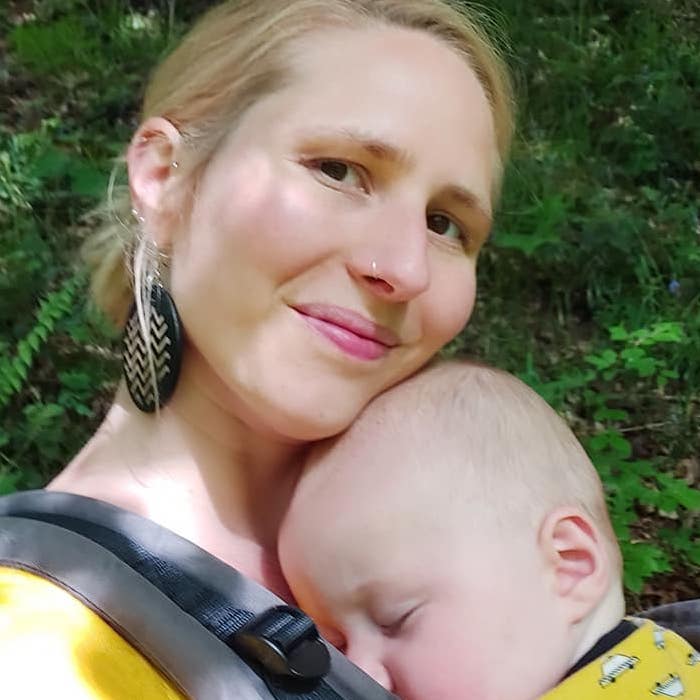While most crafters are familiar with standard domestic sewing machines, those who work with textiles know that they’re not the perfect choice for every project. Sometimes, specialized machinery is required to work with thicker materials, larger projects, or to perform unique stitches and embroidery.
From home use to mass production, there are quite a few different types of sewing machines. Many are designed for industrial use, where one type of machine is used to perform a singular task, such as creating buttonholes, for efficiency, but domestic sewers also have a few types of model to choose from.
Let’s take a look at 13 types of sewing machines and the way they’re used.
Types of domestic sewing machines
Mechanical sewing machine
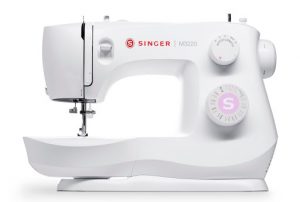
For many, the classic mechanical sewing machine is exactly what comes to mind when picturing machine sewing. It’s what a lot of us have grown up using; the learning curve is limited, and compared to electronic or computerized options, the price tag is low.
Mechanical sewing machines are operated via buttons and dials rather than a digital interface, and most basic projects can be completed with them. It’s important to keep in mind that some are extremely basic, offering few stitches and functions, while others have quite a few stitches, can create buttonholes, and are general workhorses in the sewing room. As logic dictates, the price range of mechanical machines tends to climb upwards when more features are added.
Manual sewing machine (treadle)
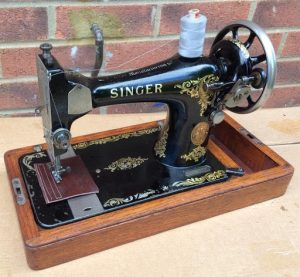
Though they’re novel and often quite beautiful, old-school hand-operated and treadle sewing machines aren’t commonly used any more. This is because they’re designed to bypass the need for electricity, instead requiring that the sewer manually operate the machine with a spinning wheel or floor pedal.
A fair amount of these machines still exist; not only were they built to last, but many were built into tables and designed to be a piece of standing furniture. If you happen to get your hands on one, you may well be able to teach yourself to use it (YouTube can surely help), but be prepared for a slow, tedious process that’s rather imprecise compared to modern machines.
It’s possible to find brand new hand-operated and treadle sewing machines, but they’re not especially common. They’re still used more commonly in parts of the world where electricity isn’t available on demand.
Computerized sewing machine
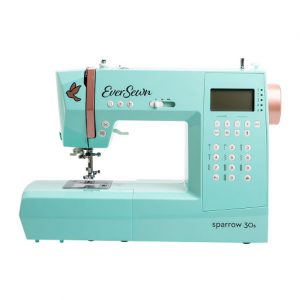
A step up from a mechanical machine, electronic and computerized sewing machines have all the function of their knob-powered counterparts, plus more. They generally operate through the use of a convenient LCD panel with clearly labeled buttons, and they automate tasks like bobbin winding, needle threading, and tension control, which can sometimes be tedious.
In almost every case, electronic sewing machines have more stitches and abilities on offer than mechanical machines. Some can identify the correct stitch type and tension for a project, self-correcting in order to achieve the most precise stitchwork.
Some computerized sewing machines have the ability to perform embroidery using a variety of proprietary designs or those uploaded to the machine by the user. This feature isn’t present on every electronic machine, so shop carefully.
The multitude of features on offer and the ease of use of electronic sewing machines means that they often fall at the higher end of the price range, which is especially true if the machine is able to perform embroidery or has a quilting-friendly long-arm design.
Quilting sewing machine
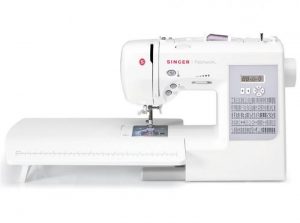
Also called a long-arm sewing machine, these handy builds are ideal for quilters thanks to the extra flat space provided by the titular arm. This provides a space for large swaths of fabric to lay securely while they are being worked on.
Their function is very similar to a domestic sewing machine, and they can be used to craft and repair just as a smaller machine would be. One key difference is their ability to successfully sew through thick or multi-layered projects, which is needed for the creation of quilts but sometimes isn’t achievable with a mechanical machine.
Quilting machines are available in both mechanical and electronic. As is the case with smaller domestic machines, electronic models can perform more stitches, feature more quality-of-life automations, and are, of course, more expensive.
Embroidery machine
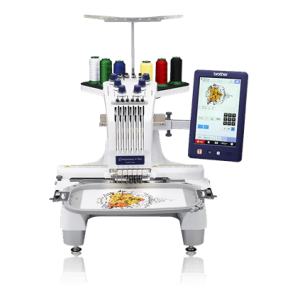
Embroidery, a specific type of decorative stitchwork, is often associated with hand-sewing rather than machine. The option to automate exists for modern sewers, with some relying on electronic sewing machines that embroider and others opting for a standalone embroidery machine.
Used both domestically and commercially, these units do not function as regular sewing machines. They’re used exclusively to add embroidered designs and accents to textiles. Most embroidery machines come with a variety of pre-loaded patterns to explore, but also allow users to upload their own patterns to the machine via USB.
Types of industrial sewing machines
Heavy-duty sewing machine
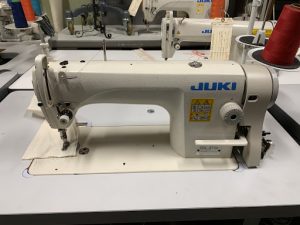
Made for heavy duty mass production of textiles, these durable machines are often built into tables in order to form a workstation. They are able to handle thicker textiles and materials than the average domestic sewing machine, and can operate at a high speed with extremely precise results.
While there are general-use industrial sewing machines like the one described above, industrial textile production generally involves the use of quite a few different machines for specific purposes. Separate machines may be used to add buttons, create hems, perform specific stitch types, and more. We’ve covered some of these more specific models below.
Chain stitch machine
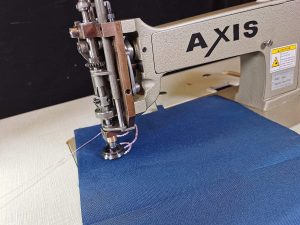
Used for seams, binding, and embroidery, these specialized machines perform chain stitch, a durable stitch that’s good for garments.
Chain stitch machines come in several varieties; they can have one or two needles, and may use one or two different types of thread. They’re used to create zigzags and straight seams exclusively.
Blind stitch machine
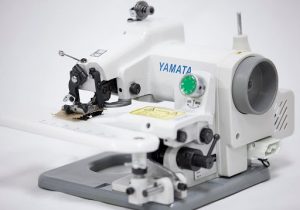
When a garment requires stitching that must be invisible, a blind stitch machine is used.
The machine can create an invisible hem or bond on a garment quickly and precisely, a feat that’s hard to accomplish any other way. Its functionality ends there, but it comes in great handy for creating garments that should have a smooth illusion when worn.
Cover stitch machine
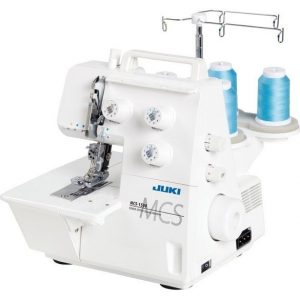
Putting a clean finish on hems, especially knits, is made much quicker and easier with the use of a cover stitch machine.
This unit makes durable seams which can move and stretch with worn fabrics, resisting tearing. It is also used to attach decorative trim, elastic, and lace. It may also be used for decorative top stitching on quilts and other textile projects.
Sergers, overlock, and overedge machine
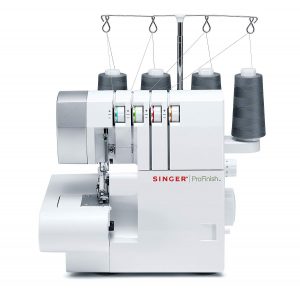
Also called overlock or overedge machines, sergers are used to give textile products a professional finish by trimming off seam allowances and fixing raw edges. They’re ideal when fabrics are flimsy and hard to sew; knits and especially heavy and light fabrics are often aided by a serger.
Sergers operate quite quickly, generally using two needles. They may use up to eight spools of thread simultaneously.
While sergers are most frequently used in industrial sewing, they’re also available as domestic machines, and some avid sewers may wish to keep one in their repertoire.
Safety stitch machine
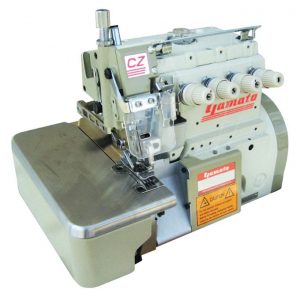
Though the functionality of this unit is often combined with that of a serger, it’s sometimes sold as a separate item called a safety stitch machine. The utility of the machine is somewhat similar, as it’s used to neaten up edges and create clean seams.
Safety stitch machines use two thread chain stitch and three thread overlock stitch for durable results.
Flat seam machine
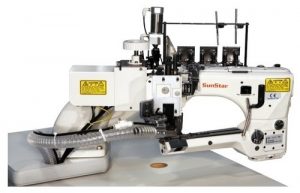
Working with knit fabrics can be tricky, as they’re flimsy and can be difficult to sew. Flat seam machines are used to create a flat seam on a knit garment or textile product. They’re also used to bind cut edges and create a final product with a seam that’s flat on both sides.
Sometimes, their functionality is combined with that of a serger. A flat seam machine may have a flat or cylindrical bed, depending on its intended use.
Bar tack sewing machine
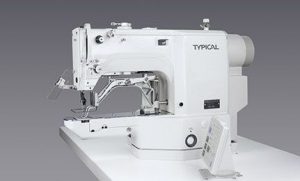
Reenforcing high tension points on garments is important to extending their life. In an industrial setting, these stitches are performed by a bar tack sewing machine.
This unit is used to create bar tacks, which are high density stitches that help to hold clothes together at their most vulnerable points. They’re often used in the making of slacks and jeans, particularly for securing the corners of belt loops and pockets.

